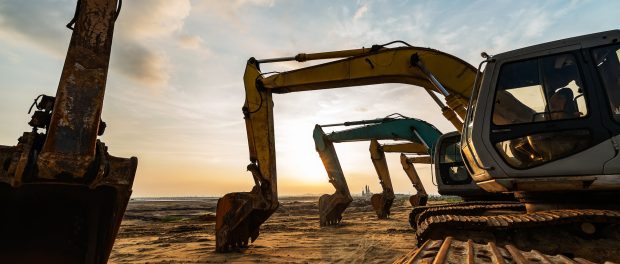The Future of Construction Is Automated—and It’s Already Here

For centuries, the construction industry has relied on human intuition, manual labour, and traditional surveying methods to bring projects to life. But today, a quiet revolution is reshaping worksites across the globe. The future of construction is automated, and it’s not a distant concept—it’s happening right now.
At the heart of this transformation is machine control, a technology that uses GPS, GNSS, lasers, sensors, and 3D models to guide earthmoving machinery with pinpoint precision. Whether it’s grading, trenching, or paving, modern machine control solutions are delivering faster, safer, and more efficient outcomes than ever before.
In an industry known for tight deadlines, labour shortages, and escalating costs, automation is more than a trend—it’s a lifeline. Here’s how machine control is changing construction as we know it.
What Is Machine Control?
Machine control refers to the use of positioning sensors, digital designs, and onboard computing systems to automate the operation of construction equipment. Excavators, bulldozers, graders, and even compactors can be fitted with these systems, allowing them to perform tasks with a level of accuracy that’s nearly impossible to achieve manually.
Depending on the type of system used, machine control can guide the operator, assist movement, or fully automate the machine’s actions. Real-time feedback from satellites or base stations ensures that blades, buckets, and booms are exactly where they need to be—every time.
Speed and Accuracy: A New Standard
In traditional earthworks, surveyors mark out levels and boundaries, operators estimate depth and angle, and rework is common. Machine control eliminates that guesswork.
With machine control solutions, construction teams can work directly from 3D digital plans. Operators see a live map of the project on their in-cab screen, showing exactly where to cut, fill, or compact. GPS and sensors ensure every movement is precise to the millimetre.
The result? Earthmoving and grading tasks that once took days can now be completed in a fraction of the time, with fewer errors and virtually no rework.
Smarter Use of Labour and Resources
One of the biggest challenges facing the construction industry is the shortage of skilled labour. As experienced operators retire, fewer people are entering the trade. Machine control helps bridge that gap.
By guiding or automating equipment, these systems reduce reliance on operator skill alone. A relatively inexperienced operator can produce professional-grade results by following digital models and system prompts. This levels the playing field and reduces the steep learning curve traditionally associated with heavy machinery.
Machine control solutions also optimise fuel usage, reduce idle time, and minimise material wastage—cutting costs and reducing the environmental footprint of a project.
Safety from the Ground Up
Construction sites can be hazardous, especially during surveying and grading phases where humans and machines often work in close proximity. Machine control enhances site safety by reducing the need for on-foot surveyors and ground crews near active machinery.
Automated systems keep equipment within defined boundaries and reduce operator fatigue by making movement more intuitive. With fewer people on the ground and less risk of human error, worksites become significantly safer.
Remote monitoring and diagnostics also mean fewer people need to be on-site, further improving safety in challenging environments like mines or major infrastructure corridors.
Seamless Integration with Digital Workflows
Machine control doesn’t operate in isolation—it’s part of a larger trend toward digitisation in construction. Projects now begin with Building Information Modelling (BIM) and 3D designs, which can be uploaded directly to the machinery’s onboard system.
This seamless data flow allows for real-time updates and remote adjustments. If plans change mid-project, new models can be uploaded instantly—no need to wait for surveyors to re-stake or re-measure. Supervisors can monitor progress remotely and make informed decisions faster.
In short, machine control connects the physical and digital worlds of construction, bringing next-level efficiency to project management.
Scalable Solutions for Projects of All Sizes
While machine control once seemed like a luxury reserved for major infrastructure projects, today’s solutions are scalable, affordable, and increasingly adopted by contractors of all sizes.
From residential developments and roadworks to civil infrastructure and mining, there are systems tailored for nearly every application. Some companies even offer “on-demand” machine control, allowing contractors to upgrade to 3D capabilities only when needed—keeping costs down while boosting flexibility.
Whether you’re running a single excavator or managing a fleet across multiple sites, there’s a machine control solution that fits.
The Competitive Advantage You Can’t Ignore
In an industry as competitive as construction, any edge matters. Projects delivered faster, more accurately, and under budget win tenders and build reputations. Machine control delivers that edge.
Contractors using machine control report significant gains in productivity, reduced rework, and better collaboration across teams. And as clients increasingly expect digital workflows and fast turnarounds, the pressure is on to modernise or fall behind.
By adopting machine control solutions, construction businesses position themselves as forward-thinking, tech-savvy, and ready to meet the demands of today’s high-stakes market.
Looking Ahead: Automation Is Only Getting Smarter
As technology continues to evolve, machine control is becoming even more advanced. AI-assisted grading, autonomous machinery, drone-integrated mapping, and cloud-based analytics are just around the corner—or already here.
The future of construction is one where machines talk to each other, workflows are digitised from start to finish, and productivity is limited only by the speed of innovation. Machine control is the foundation of this future.
Final Thoughts
The days of relying solely on manual processes and guesswork in construction are over. Machine control offers a smarter, safer, and more efficient way to build—and it’s already transforming the industry.
Whether you’re a small contractor or a major civil operator, now is the time to explore machine control solutions that match your needs. Because the future of construction isn’t coming—it’s already here. And those who embrace it will lead the way.

